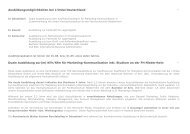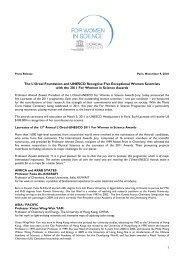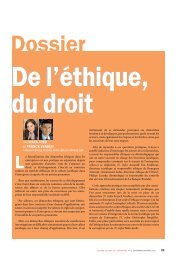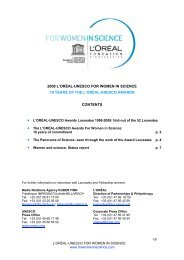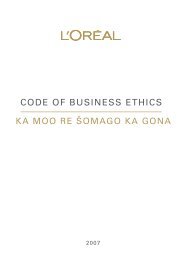CONTENTS - L'Oréal
CONTENTS - L'Oréal
CONTENTS - L'Oréal
You also want an ePaper? Increase the reach of your titles
YUMPU automatically turns print PDFs into web optimized ePapers that Google loves.
LATIN AMERICA &<br />
THE CARRIBEAN<br />
Argentina<br />
Environmental Biology<br />
María Valeria LARA, 30, PhD in Biological Sciences,<br />
is a post-doctoral researcher and lecturer in plant<br />
biochemistry at the National University of Rosario in<br />
Argentina. Her research focuses on the effect of<br />
environmental and climatic stress on the process of<br />
photosynthesis and in particular on the development of<br />
crops that can use water more efficiently under drought<br />
conditions.<br />
The safeguard of the world’s water resources is<br />
dependent on research in this area: currently some 40%<br />
of the world’s food crops are grown under artificial<br />
irrigation and 70% of the water drawn by humans from<br />
freshwater sources is used for agriculture. Plants<br />
control water-loss and CO2 intake from their leaf<br />
surface through the action of leaf guard cells. These<br />
cells have the capacity to open and close the leaf<br />
stomata (pores) by changing shape in response to<br />
environmental conditions such as light and water<br />
stress. A specific enzyme (NADP-malic enzyme) is<br />
supposed to be involved in this process.<br />
During her fellowship, Dr Lara plans to transfer the<br />
maize gene – this species use a photosynthetic pathway<br />
known as C4 – which codes for this enzyme into tobacco<br />
plants, which use a different photosynthetic pathway<br />
(C3), to see if this specific enzyme could be used as a<br />
mechanism to make other C3 plants, including<br />
important food crops such as wheat, more resistant to<br />
water stress.<br />
On her return to Argentina, Dr Lara will test her results<br />
on other plants, under differing environmental<br />
conditions, with the aim of developing drought-resistant<br />
crop plants with increased yield.<br />
Host institution: School of Biological Sciences,<br />
Washington State University, USA. �<br />
FELLOWS UNESCO-L’ORÉAL 2005<br />
Brazil<br />
Medical Science<br />
Michelle Lucinda DE OLIVEIRA, 33, a medical<br />
doctor, is currently working as an attending surgeon at<br />
department of Gastrointestinal Surgery at the Federal<br />
University of São Paulo, where she is doing postgraduate<br />
research in surgical hepatopancreaticobiliary field. Her<br />
research focus is on liver cancer and novel strategies to<br />
treat this disease.<br />
Cancer arising in the liver (primary liver cancer) is one of<br />
the commonest cancers in the world, with approximately<br />
one million new cases reported every year. The liver is<br />
also one of the main sites of secondary tumors<br />
originating from metastatic cancer cells. The liver is the<br />
only solid organ, which can regenerate and grow back to<br />
its normal size. Up to 70% of the liver can be safely<br />
removed, and it will fully regenerate within a few weeks.<br />
For this reason surgery remains the first line of<br />
treatment in many cases and the only chance of cure for<br />
patients with primary or secondary liver tumors. A<br />
frequently alternative strategy used prior to surgery is to<br />
occlude one major vein supplying blood to a large part of<br />
the liver (portal vein embolization) selectively causing<br />
liver atrophy and concomitant major regeneration in the<br />
part with intact blood supply. This strategy is very useful<br />
to enable safe resection of large liver volume (> 70% of<br />
the liver mass) containing cancer. However, how<br />
regeneration influences tumor growth in the remaining<br />
tissue and whether liver resection or portal vein<br />
embolization have similar effects is unknown.<br />
Dr de Oliveira wants to find out how liver resection and<br />
portal vein embolization influence tumor growth, and<br />
which growth factors produced by the liver are involved.<br />
The long-term goal is to enable safe resection of large<br />
liver volume while minimizing the risk of tumor<br />
recurrence after surgery.



